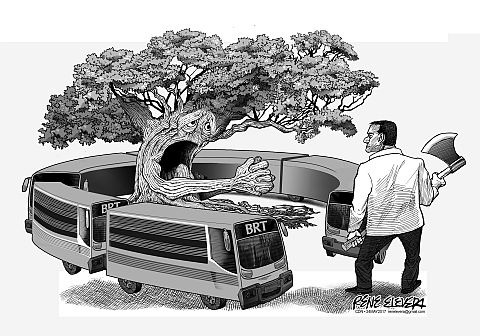Last Wednesday’s public hearing on the planned earthballing of trees and cutting of some aging ones still produced some lingering opposition, but it remains to be seen if it would gather momentum and steamroll into a viable opposition to the plan.
City Hall’s environmental advisor Nida Cabrera took pains to explain the city government’s intention to save as many of the trees as possible, preferably those endemic to the city.
A concrete declaration of that commitment was made by lawyer Rafael Yap, the city’s traffic czar and Bus Rapid Transit (BRT) project management chief, who said they will abide with existing laws on relocating trees after a meeting with some environmental groups.
It seems as if there was some leeway made with groups like the Movement for a Livable Cebu saying it agrees with the earthballing plan and acknowledged that if there would be any cutting of trees, it should be those not endemic to Cebu.
There is already an assurance from the City Environment and Natural Resources Office (Cenro) that based on their experience, the trees have a better than average chance of surviving the earthballing process and being transplanted to tree nurseries suited to them.
Other groups, however, aren’t so sympathetic and want the city government not to cut trees along the BRT route at all. Again, we are seeing a scenario similar to what happened to the Naga City-Carcar highway project that got stalled in large part due to environmental groups and advocates like Fr. Robert Reyes.
That said, it remains to be seen if they can mobilize public support for their cause similar to what happened at the highway project. It is also useful to note the changing of the guard in the leadership of the Department of Environment and Natural Resources (DENR) with former military official Roy Cimatu now at the helm.
It would have been a different situation if Gina Lopez were still environment secretary since she would have required BRT planners to revise their plans similar to what she did when she called on Cebu City Hall to close down the Inayawan landfill site.
And the city government won’t be shy about pulling strings to see that the long gestating BRT project pushes through on schedule regardless of how many ribbon strings are tied around the trees.
One cannot disregard the possibility of opposition to the tree cutting to gain traction, but if the Cebu City government is committed to earthballing the trees and mass planting new ones in their place, then public sentiment may be somewhat mollified.
That and if city residents move to adopt the trees to be displaced by the BRT project would mean they could help in preserving and giving them a new home to grow again.
Environmental advocates can oppose all they want but they also have to deal with a growing public clamor for an effective mass based transport system which the BRT represents to many city residents.
Disclaimer: The comments uploaded on this site do not necessarily represent or reflect the views of management and owner of Cebudailynews. We reserve the right to exclude comments that we deem to be inconsistent with our editorial standards.

